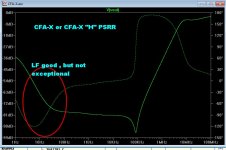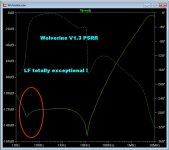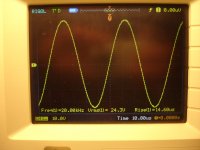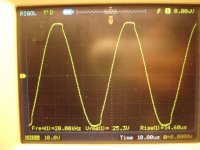@ ostripper & thimios
Sorry to hear about your situations 🙁 I could say a LOT more about who/what is causing it, but it's OT ! Maybe you already know ?
Fight the Power 😉
Sorry to hear about your situations 🙁 I could say a LOT more about who/what is causing it, but it's OT ! Maybe you already know ?
Fight the Power 😉
I know very well who /what.....@ ostripper & thimios
Sorry to hear about your situations 🙁 I could say a LOT more about who/what is causing it, but it's OT ! Maybe you already know ?
Fight the Power 😉
Attachments
thimios if you find any free time later make a test and tell us your listening impressions between cfa-x (first simple version) and cfa-x (h) v1.3. im very curious.....
hi maouna, i will try this but i must tune this ips first.thimios if you find any free time later make a test and tell us your listening impressions between cfa-x (first simple version) and cfa-x (h) v1.3. im very curious.....
First fire ok. some first measurments.
Amplifier is alive and singing now.
Finally VFA is the winner for bass ,CFA is the winner for high!
THAT'S MY OPINION
PS I agree that cfa is a cheap ips but a suitable power supply for this ampl.isn't cheap at all.
My power supply with 22000uf/rail isn't quite for this because for low PSSR
Thimios.
You are the man.
It's indeed unfortunate of our situations. We can fight the "fat cat"
corporate "scourge" by making cheaper , better audio.
I fully intend on making full IPS/OPS PCB's of the best "rumble"
candidates.
This IPS ... I took longer (more careful) consideration of both simulation
and layout. Only had to compromise to make it toner friendly (for you)
and ready for a board house.
I really does outperform all the other VSSA variants by a large margin.
PS - hopefully the "fat cats" will "pop" - I will scavenge the remains. 😀
OS
Okay guys, you have stated multiple times because of the psrr that the vfa is the better choice for bass frequencies and this makes the selection easy between the cfa and the vfa. But what if the amp has to reach up to 2.5khz, would that upper range still favor the vfa as strongly? Where does this become a grey area, how high before the advantage of one overlaps the advantage of the other. In other words where is the transition point where you would choose the CFA?
Bass is not too directional and sits behind the high distortion of the driver.
Mid's and treble have many magnitudes less as the drivers are better.
default page
(link - tweeter THD)
I feel the output stage type is the largest contributor to bass performance.
From 20 - 100hz , if the IPS can just be "adequate" <.1% , would you know
the difference ?
High current control of the woofer and the ability to negotiate the woofers
impedance and back EMF is the main concern.
In a full range system , IM distortion / psrr would have to be good. All that
LF "badness" with the soundstage riding on top of it.
I've decided to at least go 2.1 with a dedicated sub.
For a full- range with less demanding bass ( no 20-60hz) , any CFA would do.
Running a 2.1 , I notice the 20-100hz uses 100W+ , while the satellites are
just "sipping" 10 watts for 200hz - 20K.
What I'm saying ... there just isn't much energy above 200hz (as compared
to LF). It won't cause a lot of ripple at the point where a cfa is "weak"
(below 1 -LF) ... <1k.
On the other hand , the VFA's PSRR at 10-200hz is at it's strongest (below 2)
- 130DB/ 20-50hz ..... piece of "junk" power supply, no problem !
But this is good , as the massive current required from sub-sonics to 100hz
will cause 10X the ripple on ANY linear PS.
There you have it ... hope this explains . 🙂
PS - at 2.5khz either amp would be good. At this freq. - no massive ripple ,
(as compared to a 4R sub @ 20mm Xmax !) The CFA's attributes might
make for a better soundstage.
OS
Mid's and treble have many magnitudes less as the drivers are better.
default page
(link - tweeter THD)
I feel the output stage type is the largest contributor to bass performance.
From 20 - 100hz , if the IPS can just be "adequate" <.1% , would you know
the difference ?
High current control of the woofer and the ability to negotiate the woofers
impedance and back EMF is the main concern.
In a full range system , IM distortion / psrr would have to be good. All that
LF "badness" with the soundstage riding on top of it.
I've decided to at least go 2.1 with a dedicated sub.
For a full- range with less demanding bass ( no 20-60hz) , any CFA would do.
Running a 2.1 , I notice the 20-100hz uses 100W+ , while the satellites are
just "sipping" 10 watts for 200hz - 20K.
What I'm saying ... there just isn't much energy above 200hz (as compared
to LF). It won't cause a lot of ripple at the point where a cfa is "weak"
(below 1 -LF) ... <1k.
On the other hand , the VFA's PSRR at 10-200hz is at it's strongest (below 2)
- 130DB/ 20-50hz ..... piece of "junk" power supply, no problem !
But this is good , as the massive current required from sub-sonics to 100hz
will cause 10X the ripple on ANY linear PS.
There you have it ... hope this explains . 🙂
PS - at 2.5khz either amp would be good. At this freq. - no massive ripple ,
(as compared to a 4R sub @ 20mm Xmax !) The CFA's attributes might
make for a better soundstage.
OS
Attachments
Last edited:
Why is PSSR a measure for base performance..??
I would consider output impedance, PSU storage and and gorunding much mre important issues.
I would consider output impedance, PSU storage and and gorunding much mre important issues.
Bass is not too directional and sits behind the high distortion of the driver.
Mid's and treble have many magnitudes less as the drivers are better.
default page
(link - tweeter THD)
I feel the output stage type is the largest contributor to bass performance.
From 20 - 100hz , if the IPS can just be "adequate" <.1% , would you know
the difference ?
High current control of the woofer and the ability to negotiate the woofers
impedance and back EMF is the main concern.
In a full range system , IM distortion / psrr would have to be good. All that
LF "badness" with the soundstage riding on top of it.
I've decided to at least go 2.1 with a dedicated sub.
For a full- range with less demanding bass ( no 20-60hz) , any CFA would do.
Running a 2.1 , I notice the 20-100hz uses 100W+ , while the satellites are
just "sipping" 10 watts for 200hz - 20K.
What I'm saying ... there just isn't much energy above 200hz (as compared
to LF). It won't cause a lot of ripple at the point where a cfa is "weak"
(below 1 -LF) ... <1k.
On the other hand , the VFA's PSRR at 10-200hz is at it's strongest (below 2)
- 130DB/ 20-50hz ..... piece of "junk" power supply, no problem !
But this is good , as the massive current required from sub-sonics to 100hz
will cause 10X the ripple on ANY linear PS.
There you have it ... hope this explains . 🙂
PS - at 2.5khz either amp would be good. At this freq. - no massive ripple ,
(as compared to a 4R sub @ 20mm Xmax !) The CFA's attributes might
make for a better soundstage.
OS
Is there significant gain difference on heights?
Why is PSSR a measure for base performance..??
I would consider output impedance, PSU storage and and gorunding much mre important issues.
More PSSR would have advantages for a total fullrange loudspeaker
(25/30 -20Khz) , especially if you run it off a single linear supply.
This is why the typical Japanese OEM will use a VFA ... so they can
"economize" the PS ($$$$). 😀
The high PSRR will not allow the bass to adversely affect the HF
performance.
I can simulate PS- LF ( 30-100hz) ripple on the VFA wolverine and
THD 20K will only deviate by a few PPM.
This is NOT the same on the CFA's.
EACH has it strengths and weaknesses.
OS
Maybe "lost in translation" ?? Try re-wording that. 😕Is there significant gain difference on heights?
OS
Maybe "lost in translation" ?? Try re-wording that. 😕
OS
Sorry, is there significant open loop gain difference on high frequencies between the two models?
cfa-x
Now some other measurments.
What I have to emphasize is that it has a better response to low (compared to the standard version) but at the expense of the high, at least what I understood from the first hearing.
Thimios
Now some other measurments.
What I have to emphasize is that it has a better response to low (compared to the standard version) but at the expense of the high, at least what I understood from the first hearing.
Thimios
Attachments
Last edited:
Sorry, is there significant open loop gain difference on high frequencies between the two models?
Yes , the VFA has almost 100db and
all my CFA's are about 60db.
The VFA's need to have all this gain to have margin and
usable FB gain @ 20K.
The CFA's gain doesn't even start to drop till 10K+ 🙂 .
OS
Now some other measurments.
That is the best looking 200K SW yet !😎
The slight "sticking" on clip is minor - does not seem to be excessive. 🙂
The trade-off you mention can be tweaked with the compensation options.
I notice LF vs. HF differences - (CM1/2) vs. the (C13-C14) schemes.
Using either compensation along with value adjustment of R17-18 can produce many
harmonic profiles in this amp (that is why I included them as "options").
PS - your "rounded off" SW results .... you are nowhere near "ringing" (C) values could
be reduced considerably (higher slew) !!
OS
Last edited:
O stipper,, Good PSSR matters nothing when it comes to base performance. With less capacitance and a weak transformer all you'll achieve is to modulate the power GND. In that respect there's absolutely no free lunch.
Yes , the VFA has almost 100db and
all my CFA's are about 60db.
The VFA's need to have all this gain to have margin and
usable FB gain @ 20K.
The CFA's gain doesn't even start to drop till 10K+ 🙂 .
OS
And how it simulate 20kHz? Do cfa have higher gain there?
Please OS ,Because my English isn't good .....can you give some datails on shematic diagrame?That is the best looking 200K SW yet !😎
The slight "sticking" on clip is minor - does not seem to be excessive. 🙂
The trade-off you mention can be tweaked with the compensation options.
I notice LF vs. HF differences - (CM1/2) vs. the (C13-C14) schemes.
Using either compensation along with value adjustment of R17-18 can produce many
harmonic profiles in this amp (that is why I included them as "options").
PS - your "rounded off" SW results .... you are nowhere near "ringing" (C) values could
be reduced considerably (higher slew) !!
OS
PS I used 33p for c13-c14 and trimmers for CM1/2 THEN i adjust these trimmers for best looking sqerewave at 100khz
Power supply transformer is a toroidal 2x35v/300w(one channel configuration) ,filter capacitors 2x22000uf ,Rload=4R idle current=25ma ,OUT is one pair c3264 a12195.
Last edited:
O stipper,, Good PSSR matters nothing when it comes to base performance. With less capacitance and a weak transformer all you'll achieve is to modulate the power GND. In that respect there's absolutely no free lunch.
It seems most IC manufacturers and audio authors disagree with this ?
Google "PSRR in audio " (277K results) ... includes class D , analog IC OEM's ,
and most of our beloved forum authors.
PDF's , papers , AES ... etc !!
They all tout "excellent PSRR" as an attribute to the quality of their "wares".
Just "marketing hype" ?? 😀
OS
Please OS ,Because my English isn't good .....can you give some datails on shematic diagrame?
PS I used 33p for c13-c14 and trimmers for CM1/2 THEN i adjust these trimmers for best looking sqerewave at 100khz
I intended for the use of EITHER "cm1/2" OR C13-14 in addition to R17/18.
... It will work , but either the "shunt" OR miller is used (not both).
You are likely overcompensated !
OS
- Home
- Amplifiers
- Solid State
- Slewmaster - CFA vs. VFA "Rumble"







